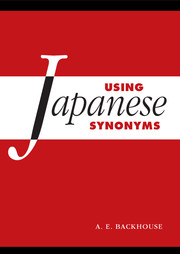Introduction
Published online by Cambridge University Press: 05 August 2016
Summary
General
Learning the vocabulary of a foreign language is fascinating, not least because languages differ in unexpected ways in quite basic lexical distinctions. English water may be hot or cold, but Japanese distinguishes between oyu for the first and mizu for the second. While English has a single basic verb give, Japanese distinguishes two such verbs in terms of the direction of the act of giving, kureru (for ‘incoming’ giving, directed towards the speaker) and ageru (for other cases). Vocabulary learning is also demanding, above all because of the sheer magnitude of the task. The words and other lexical items of a language number in the tens, if not hundreds, of thousands, and the acquisition of vocabulary is truly a vast undertaking.
The aim of bilingual dictionaries of various kinds is precisely to help the learner in this task. Like other volumes in the series, Using Japanese Synonyms organizes Japanese vocabulary by areas of meaning: words like mizu and oyu, or kureru and ageru, are described and illustrated in the same semantic grouping, or frame, thereby bringing into focus both their similarities as a group and the distinctions between them.
In this way, the volume is designed to help English-speaking learners to improve their lexical competence in both comprehension and production by acquiring a greater awareness of the details of meaning and use of Japanese lexical items in various semantic areas. Meaning-and-use involves several dimensions. Firstly and most obviously, it includes the content of a word, in the sense of the range of phenomena it is used to refer to: if learners of Japanese overextend mizu in use or misunderstand it as referring to hot water (as experience indicates they often do), communication will be impaired. Secondly, in order to use a word naturally in a phrase or sentence, we also need an appreciation of how it interacts with other words that commonly accompany it: for example, in English, boil water is a natural combination of words, but what is the Japanese counterpart: oyu o wakasu, or mizu o wakasu?
- Type
- Chapter
- Information
- Using Japanese Synonyms , pp. 1 - 8Publisher: Cambridge University PressPrint publication year: 2016

